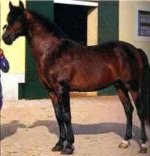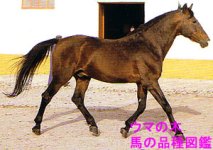♘امیرحسین♞
♘ مدیریت انجمن اسب ایران ♞
The Alter-Real is a breed of horse that originated in Portugal. Their name comes the village Alter do Chão. They are an Iberian breed and are considered Baroque horses. They are closely related to the more common Lusitano.
History
The Alter Real was established in 1748 by the House of Braganza in Villa do Portel. The purpose was to provide horses for the Royal Stables at Lisbon that were suitable for classical equitation, and also, good carriage horses. After 8 years the stud was moved to Alter, a town known for mineral rich soil and a high nutrient content in grazing. That explains the first part of the name, as for real, that is Portuguese for royal. The breed was started with 300 Andalusian mares, imported from Spain, and Arabian stallions. In the Peninsular War (1804-14), much of the stock was spread by the French troops; Napoleon's forces took all the best horses. In 1834, when King Dom Miguel I de Bragança abdicated the throne, a lot of the stud's land was taken, and the stud was ordered to close. Attempts were made to revitalize the stock, with Hanoverian, Norman, English and Arabian stock, but none were very successful, and the Arab blood had a particularly bad influence. In the late 1800s Andalusian blood was added, and this is what finally improved the stock. When the monarchy in Portugal ended, the stud, and consequently the breed, would have disappeared. Ruy d'Andrade, Portugal's greatest equestrian authority, prevented this. He was able to save a small amount of Alter Real breeding stock, and he line bred successfully to 2 stallions. In 1932 the stud was given over to the Portuguese Ministry of Agriculture. Since then the breed has been improved by culling out unsuitable mares and using only the finest stallions. There are still not a great deal of Alter Reals, but they're not in danger, and they are a part of Portugal's cultural heritage.
Characteristics
It has been said that the modern day Alter Reals look like the original breed from the 1700s. The breed has extravagant action and great knee flexion. Standing between 15 and 16 hh, the primary colors are bay, brown, grey, and occasionally chestnut. The neck is arched, muscular, short and naturally carried high. A powerful, well placed hock contributes to action. The body is short and croup slopes to a low-set tail. The head resembles that of the Andalusian or Lusitano in profile. They are intelligent and high-strung, and overall suited for a horse used for baroque classicism.
History
The Alter Real was established in 1748 by the House of Braganza in Villa do Portel. The purpose was to provide horses for the Royal Stables at Lisbon that were suitable for classical equitation, and also, good carriage horses. After 8 years the stud was moved to Alter, a town known for mineral rich soil and a high nutrient content in grazing. That explains the first part of the name, as for real, that is Portuguese for royal. The breed was started with 300 Andalusian mares, imported from Spain, and Arabian stallions. In the Peninsular War (1804-14), much of the stock was spread by the French troops; Napoleon's forces took all the best horses. In 1834, when King Dom Miguel I de Bragança abdicated the throne, a lot of the stud's land was taken, and the stud was ordered to close. Attempts were made to revitalize the stock, with Hanoverian, Norman, English and Arabian stock, but none were very successful, and the Arab blood had a particularly bad influence. In the late 1800s Andalusian blood was added, and this is what finally improved the stock. When the monarchy in Portugal ended, the stud, and consequently the breed, would have disappeared. Ruy d'Andrade, Portugal's greatest equestrian authority, prevented this. He was able to save a small amount of Alter Real breeding stock, and he line bred successfully to 2 stallions. In 1932 the stud was given over to the Portuguese Ministry of Agriculture. Since then the breed has been improved by culling out unsuitable mares and using only the finest stallions. There are still not a great deal of Alter Reals, but they're not in danger, and they are a part of Portugal's cultural heritage.
Characteristics
It has been said that the modern day Alter Reals look like the original breed from the 1700s. The breed has extravagant action and great knee flexion. Standing between 15 and 16 hh, the primary colors are bay, brown, grey, and occasionally chestnut. The neck is arched, muscular, short and naturally carried high. A powerful, well placed hock contributes to action. The body is short and croup slopes to a low-set tail. The head resembles that of the Andalusian or Lusitano in profile. They are intelligent and high-strung, and overall suited for a horse used for baroque classicism.


